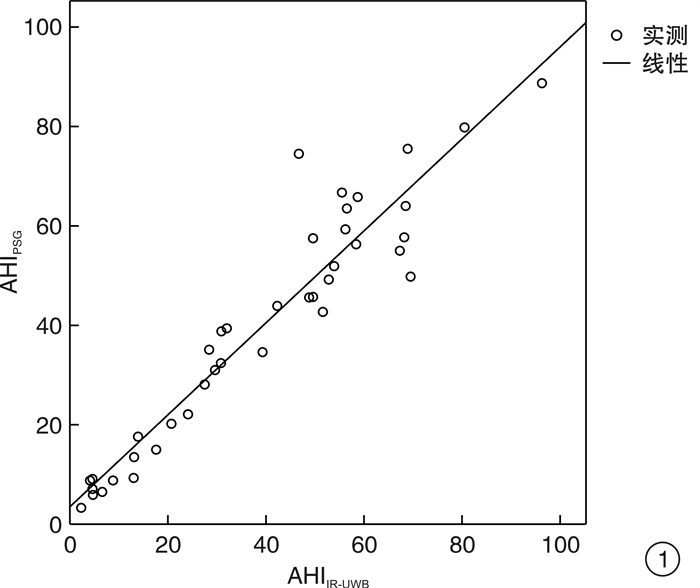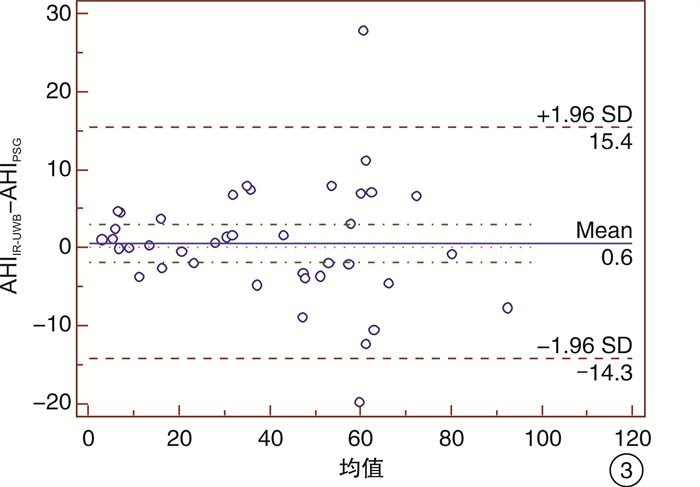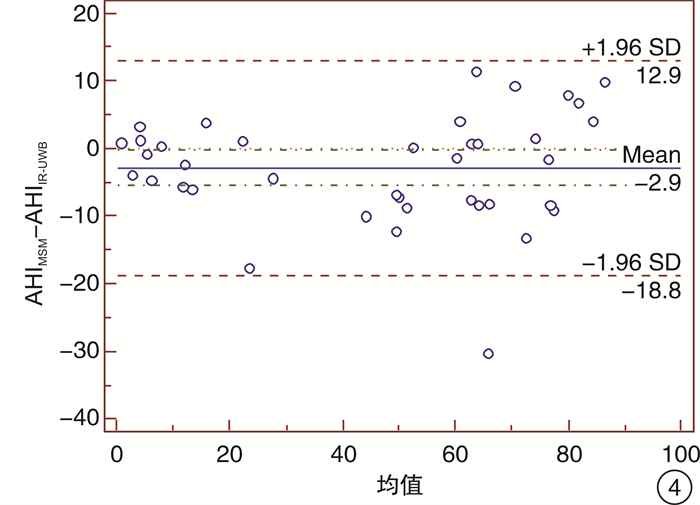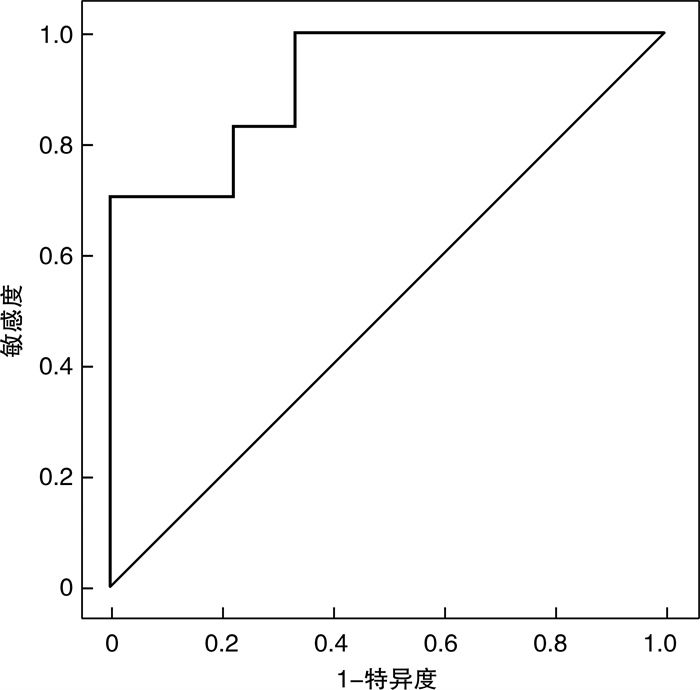Application of impulse-radio ultra-wideband radar as a non-contact portable monitoring device for the diagnosis of obstructive sleep apnea
-
摘要: 目的 研究应用脉冲无线电超宽带(IR-UWB)雷达技术对诊断阻塞性睡眠呼吸暂停(OSA)的价值。方法 将79例OSA患者随机分为2组: A组40例患者同时接受PSG和IR-UWB监测, B组39例同时接受微动敏感床垫式睡眠监测设备(MSM)和IR-UWB监测。采用Pearson相关、ROC曲线等对测定的数据进行比较。结果 AHIPSG、AHIMSM与AHIIR-UWB显著相关(r=0.91、P=0.00, r=0.92、P=0.00);Bland-Altman分析显示AHIPSG值、AHIMSM值与AHIIR-UWB值的结果一致率很高(95.00%、97.44%), 其诊断结果一致率很高。AHIIR-UWB相对于PSG检出率为敏感性70.40%、特异性89.90%, ROC曲线下面积为0.915。结论 IR-UWB在最低血氧饱和度、平均血氧饱和度、平均中枢型次数、平均混合型次数、平均心率、睡眠效率、REM睡眠时长、平均AHI等方面对于成人OSA有很高的诊断价值, 是一种经济实用的客观睡眠评估工具。
-
关键词:
- 脉冲无线电超宽带雷达技术 /
- 睡眠呼吸暂停, 阻塞性 /
- 多道睡眠描记术
Abstract: Objective To compare the effect of impulse-radio ultrawideband(IR-UWB) radar technology and polysomnography(PSG) in sleep assessment.Method A total of 79 OSA patients were randomly divided into two groups: 40 patients in group A received PSG and IR-UWB, and 39 patients in group B received micromovement sensitive mattress(MSM) and IR-UWB. Pearson correlation and ROC curve were used for statistics.Result AHIPSGand AHIMSMwere significantly correlated with AHIIR-UWB(r=0.91, P=0.00; r=0.92, P=0.00). Bland-Altman analysis showed that AHIIR-UWBvalue was highly consistent with AHIPSGvalue(95.00%), and AHIIR-UWB value(97.44%). The sensitivity and specificity of AHIIR-UWBcompared with PSG were 70.40% and 89.90%, respectively. The area under ROC curve was 0.915.Conclusion IR-UWB has a high diagnostic value for adult OSA in terms of minimum blood oxygen saturation, average blood oxygen saturation, average number of central sleep apnea, average number of complex sleep apnea, average heart rate, sleep efficiency, REM sleep duration, average AHI, etc. It is an economic and practical sleep evaluation tool. -

-
表 1 A、B组部分数据均值对比
不同测量指标 A组 B组 PSG IR-UWB 差值 MSM IR-UWB 差值 最低血氧饱和度/% 72.88±13.73 73.61±11.75 0.73 72.44±10.80 70.05±15.90 -2.39 平均血氧饱和度/% 94.25±2.37 93.93±2.53 -0.32 91.44±3.46 92.72±3.38 1.28 最长低通气时间/s 72.66±26.59 73.63±18.02 0.97 53.44±20.70 72.82±12.66 19.38 平均阻塞型次数/次 199.40±103.88 285.80±192.01 86.40 328.50±233.19 367.28±230.85 38.78 平均中枢型次数/次 34.05±52.66 24.15±8.23 -9.90 9.77±16.72 13.10±22.28 3.33 平均混合型次数/次 32.05±35.63 24.23±8.36 -7.82 6.08±7.16 9.08±16.87 3.00 最大心率/次 161.78±35.89 98.55±10.05 -63.23 93.87±12.50 111.59±31.35 17.72 最小心率/次 48.58±6.65 47.50±4.98 -1.08 57.69±7.16 46.56±5.73 -11.13 平均心率/次 69.58±10.12 67.30±9.13 -2.28 72.13±11.04 69.26±11.51 -2.87 睡眠效率/% 88.58±8.24 88.98±7.85 0.40 92.52±4.48 86.84±9.42 -5.68 REM睡眠时长/min 84.69±33.51 90.14±32.29 5.45 95.96±23.34 96.91±33.19 0.95 浅睡期时长/min 302.52±113.46 217.20±63.22 -85.32 255.63±57.77 225.41±58.50 -30.22 深睡期时长/min 86.94±67.06 127.28±43.95 40.34 137.72±37.43 139.92±56.20 2.20 平均AHI 39.49±23.87 38.91±24.56 -0.58 44.83±29.14 47.77±28.71 2.94 -
[1] 卢迷, 房芳, 魏永祥. 便携式监测设备在成人阻塞性睡眠呼吸暂停低通气综合征诊断中的临床应用[J]. 中华耳鼻咽喉头颈外科杂志, 2019, 54(6): 477-480. doi: 10.3760/cma.j.issn.1673-0860.2019.06.016
[2] Young T, Palta M, Dempsey J, et al. The occurrence of sleep-disordered breathing among middle-aged adults[J]. N Engl J Med, 1993, 328(17): 1230-1235. doi: 10.1056/NEJM199304293281704
[3] Peppard PE, Young T, Barnet JH, et al. Increased prevalence of sleep-disordered breathing in adults[J]. Am J Epidemiol, 2013, 177(9): 1006-1014. doi: 10.1093/aje/kws342
[4] Strollo PJ, Rogers RM. Current concepts: Obstructive sleep apnea[J]. N Engl J Med, 1996, 334(2): 99-104. doi: 10.1056/NEJM199601113340207
[5] Collop NA, Anderson WM, Boehlecke B, et al. Clinical guidelines for the use of unattended portable monitors in the diagnosis of obstructive sleep apnea in adult patients[J]. J Clin Sleep Med, 2007, 3(7): 737-747. doi: 10.5664/jcsm.27032
[6] Rosa T, Bellardi K, Viana A, et al. Digital health and sleep-disordered breathing: A systematic review and meta-analysis[J]. J Clin Sleep Med, 2018, 14(9): 1605-1620. doi: 10.5664/jcsm.7346
[7] Meng LL, Xu HJ, Guan J, et al. Validation of a novel sleep-monitoring system for diagnosing obstructive sleep apnea: A comparison with polysomnography[J]. Exp Ther Med, 2016, 12(5): 2937-2941. doi: 10.3892/etm.2016.3721
[8] Kim BH, Han SJ, Kwon GR, et al. Signal processing for tracking of moving object in multi-impulse radar network system[J]. Int J Distrib Sens N, 2015, 11(10): 1-12.
[9] Huang Q, Qu LL, Wu BH, et al. Uwb through-wall imaging based on compressive sensing(vol 48, pg 1408, 2010)[J]. IEEE T Geosci Remote, 2010, 48(3): 1634-1634. doi: 10.1109/TGRS.2010.2041284
[10] Lampe L, Witrisal K. Challenges and recent advances in ir-uwb system design[J]. IEEE Int Symp Circ S, 2010, pp: 3288-3291.
[11] Pallesen S, Gronli J, Myhre K, et al. A pilot study of impulse radio ultra wideband radar technology as a new tool for sleep assessment[J]. J Clin Sleep Med, 2018, 14(7): 1249-1254. doi: 10.5664/jcsm.7236
[12] Kang S, Lee Y, Lim YH, et al. Validation of noncontact cardiorespiratory monitoring using impulse-radio ultra-wideband radar against nocturnal polysomnography[J]. Sleep Breath, 2019, [Epub Ahead of Print]
[13] Lee Y, Park JY, Choi YW, et al. A novel non-contact heart rate monitor using impulse-radio ultra-wideband(ir-uwb)radar technology[J]. Sci Rep, 2018, 8(1): 13053. doi: 10.1038/s41598-018-31411-8
-





 下载:
下载:



